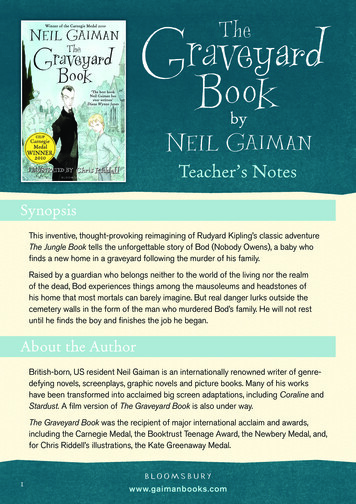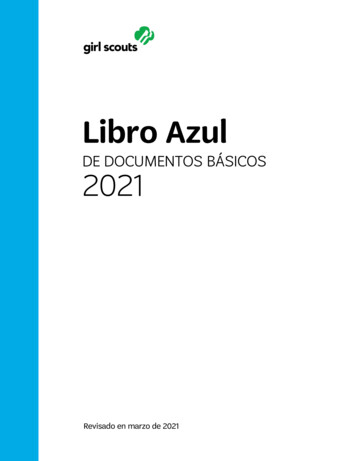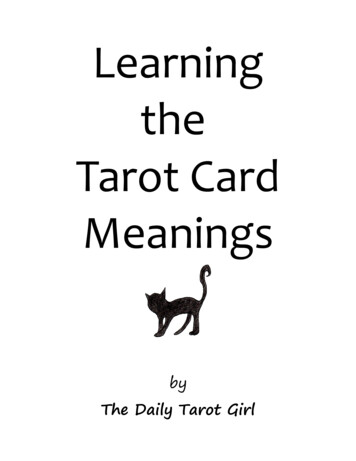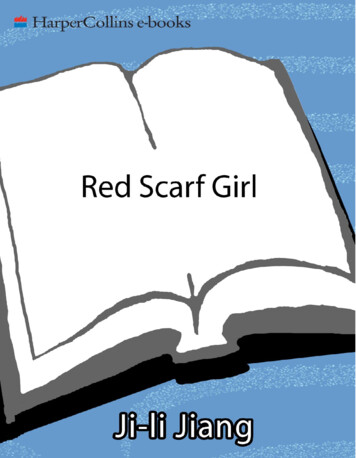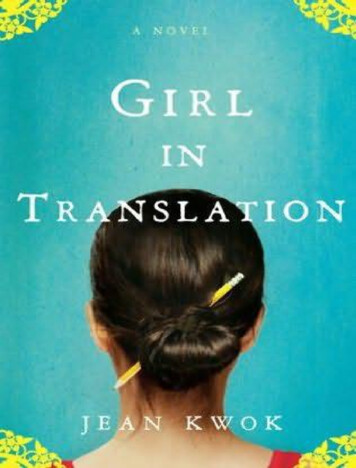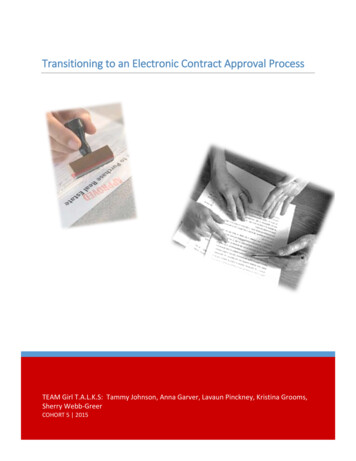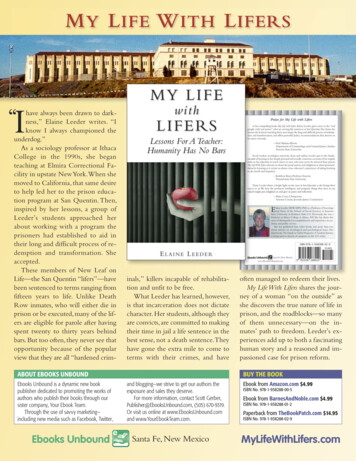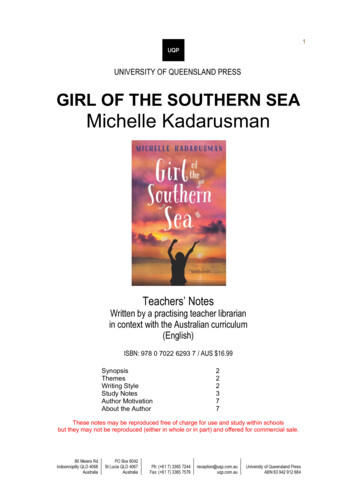
Transcription
1UNIVERSITY OF QUEENSLAND PRESSGIRL OF THE SOUTHERN SEAMichelle KadarusmanTeachers’ NotesWritten by a practising teacher librarianin context with the Australian curriculum(English)ISBN: 978 0 7022 6293 7 / AUS 16.99SynopsisThemesWriting StyleStudy NotesAuthor MotivationAbout the Author222377These notes may be reproduced free of charge for use and study within schoolsbut they may not be reproduced (either in whole or in part) and offered for commercial sale.80 Meiers RdIndooroopilly QLD 4068AustraliaPO Box 6042St Lucia QLD 4067AustraliaPh: ( 61 7) 3365 7244Fax: ( 61 7) 3365 7579reception@uqp.com.auuqp.com.auUniversity of Queensland PressABN 63 942 912 684
2UNIVERSITY OF QUEENSLAND PRESSSYNOPSISAs a young girl, Nia created stories about her heroine, the mythical Javaneseprincess Dewi Kadita. Now fourteen, Nia is desperate to continue her educationand become a writer, however, high school tuition fees are beyond her means.Her father sells banana fritters at the train station, but he drinks most of theirearnings away. Left to run the household, the food cart and care for her littlebrother, it seems Nia will forever be trapped in the impoverished slums ofJakarta.But Nia is determined to defy her unfortunate circumstances. After she survivesa minibus accident, she is convinced by an onlooker to charge double for herfried bananas because she has been blessed by ‘good luck magic’. She quicklydiscovers though, that selling superstitions is dishonest, and before long, herfuture slips further from her grasp. Determined to write her own story, shesummons tremendous courage to pursue her dreams.Girl of the Southern Sea is an inspiring novel about the power of storytelling,and the importance of hope, grit and independence.THEMES Courage Friendship Poverty Javanese folktales Hope Storytelling Education IndonesiaWRITING STYLEGirl of the Southern Sea is told through the first-person perspective of Nia. Byintegrating Nia’s narration with her stories about Dewi Kadita and dreams of hermother, Kadarusman effectively entwines themes of love and loss to highlightthe power of storytelling. Her stark depiction of setting and characters createsan engaging, often confronting text that reflects notions of right and wrong in anenvironment in which basic needs are rarely met. Not only that, it shares difficultstories inspired by the realities of girls in Indonesia. This results in a book that isdifficult to put down, with broad appeal to early adolescent readers. In addition,80 Meiers RdIndooroopilly QLD 4068AustraliaPO Box 6042St Lucia QLD 4067AustraliaPh: ( 61 7) 3365 7244Fax: ( 61 7) 3365 7579reception@uqp.com.auuqp.com.auUniversity of Queensland PressABN 63 942 912 684
3UNIVERSITY OF QUEENSLAND PRESSthe author’s effective use of figurative language strengthens a sense ofconnection with Nia and her story. Importantly, Girl of the Southern Sea doesnot offer simple solutions; rather, it weaves together Nia’s story in a way thatdemonstrates her willingness and ability to stand up for herself. It is certainly atext that helps readers to appreciate the value of education, health care, andlegitimate systems of justice, but also the importance of hope and courage.STUDY NOTES: The first chapter introduces readers to the slums of Jakarta. How do theopening paragraphs of Girl of the Southern Sea reveal Nia’s situation?How has the author evoked an instant sense of empathy with Nia? Whyis it important that readers feel a connection with a novel’s protagonist? As you read the text, take note of the way the author describes thesetting. What language features has she used to depict the slums ofJakarta so vividly? After reading Chapter 1, make predictions about the story. Continue torevisit and revise these predictions as you read. Use Chapter 2 to examine the literal and implied information that showshow poor Nia and her family are. How do we know that the relationship between Bapak and his children isdeteriorating? Why is he so dismissive of Rudi? Why is the wedding chest so precious to Nia? Why does she look at itstreasures so often? How does the kebaya and gold comb play such aspecial role in Girl of the Southern Sea? Discuss the author’s use of figurative language throughout the text.Examples include:o A hulking figure is looming towards me, swaying from side to sidelike an overloaded train carriage (p. 4)o The morning air hangs heavy with heat (p. 8)o the early dawn doesn’t provide relief from the suffocatingtemperature (p. 8)o A sour smell wafts from his body (p. 8)o His feet poke out from the blanket like small brown rabbit ears(p. 9)o His heavy shuffle and hooded eyelids betray his hangover (p. 12)o She snickers in a way that stirs a fire inside my belly (p. 20)80 Meiers RdIndooroopilly QLD 4068AustraliaPO Box 6042St Lucia QLD 4067AustraliaPh: ( 61 7) 3365 7244Fax: ( 61 7) 3365 7579reception@uqp.com.auuqp.com.auUniversity of Queensland PressABN 63 942 912 684
4UNIVERSITY OF QUEENSLAND PRESS o shacks along the train tracks shake like there’s anearthquake every time a train goes by (p. 22)o Eating one of her banana fritters was like biting into a sweet cloud(p. 24)o ‘ you kicked like an angry water buffalo’ (p. 25)o ‘He was howling in pain like a speared boar’ (p. 40)o there is a line-up snaking its way from the door out to the street(pp. 43–44)o His skin looks angry – it is raw and blistering where the hot oil hasfried it (p. 48)o The doctor interrupts the flood of memories (p. 49)o Soot from exhaust fumes creeps up my nostrils and clings to myskin, coating me in a film of grime and sweat (p. 60)o I swallow my fury and bury my face in my hands (p. 64)o His voice sounds thick with sleep (p. 74)o The night sky is a cobalt blanket littered with sparklingjewels. The jewels are stars (p. 78)o The passing traffic swirls up blankets of dust that sting my eyes(p. 85)o ‘She landed light as a feather’ (p. 90)o I feel like the wind has been completely knocked out of me (p. 92)o Others watch me intently like I am a rare bird that might flap awayany second (p. 109)o words stick in my throat (p. 112)o The mob disbands and melts back into the market (p. 137)o the lid gapes open like the mouth of a dead animal (p. 145)o Then anger rises up in me like a tidal wave (p. 157)o My head rattles as I try to make sense of the information (p. 162)o His slap is sharp, and the pain flashes bright (p. 173)o Kids dive in from the muddy riverbank, their heads popping up likecorks from under the brown water (p. 189)o Industrial areas give way to a patchwork of rice plateaus (p. 193)Why is Nia sceptical about the stories in the Flying Gazette? Why hasthe author included this element to the story?How important is education to Nia? How do we know? Why isn’t it asimportant to Yuli?Discuss the way in which the author drip-feeds details about Nia’smother to readers. Why has she done this in this way?80 Meiers RdIndooroopilly QLD 4068AustraliaPO Box 6042St Lucia QLD 4067AustraliaPh: ( 61 7) 3365 7244Fax: ( 61 7) 3365 7579reception@uqp.com.auuqp.com.auUniversity of Queensland PressABN 63 942 912 684
5UNIVERSITY OF QUEENSLAND PRESS Create a visual representation that contrasts the shack in the slums withthe Lembang house Mama and Bapak dreamt of building (see p. 23).How important are Nia’s stories to Rudi? Why does he love to hear themrepeatedly?How does the funeral for Nia’s mother show how very loved she was?How does this help you to empathise with Bapak?Nia loves to write stories about Dewi Kadita. Using some of her ideas onp. 31, write your own Dewi Kadita folktale.Explore folktales from your own culture. Share these with the class.Discuss the relationship between Nia and Rudi. Why are they soimportant to one another?How does Nia use writing and the stories of Dewi Kadita to help her?Nia says, ‘the only way to quiet my thoughts is to write’ (p. 64). Whatdoes she mean by this? In a reflection, discuss how you quiet yourthoughts.Nia writes Rudi a story for his birthday. Write a story of your own to giveto a friend or relative as a gift.In what ways does Nia reach out to Jango? Why does he help her?Discuss the role of Jango in the story. In what ways does his characterdevelop throughout the text?Discuss the role played by Mr Surat in Girl of the Southern Sea. Who, inyour personal journey, is your ‘Mr Surat’? Share in a reflection.In the role of Nia, write a journal entry to express your bittersweetfeelings about having good grades but not enough money to attend highschool.What impact does Alit’s death have on Nia? Why does she apologise tohim after her ordeal with the mob?Why does Nia go along with Oskar’s plan to double the price of herbanana fritters? At what point does she begin to have regrets about this?What were your initial thoughts when Big Sula’s mother bought frittersfrom Nia? Why was this included in the text?In the role of Nia, write and perform a monologue to express yourfeelings towards Bapak.Why is Jimi so disappointed in Nia? How does this prompt her to act in amanner more commensurate with her values?How do Nia’s choices damage her relationships? How does she restorethese?80 Meiers RdIndooroopilly QLD 4068AustraliaPO Box 6042St Lucia QLD 4067AustraliaPh: ( 61 7) 3365 7244Fax: ( 61 7) 3365 7579reception@uqp.com.auuqp.com.auUniversity of Queensland PressABN 63 942 912 684
6UNIVERSITY OF QUEENSLAND PRESS Why does Ibu Jaga step in when the mob attacks Nia? Discuss herstatement: ‘She has been foolish, but it is not up to you to judge her.That is for God only. Shame on all of you.’ (p. 136) How is this critical tothe themes of Girl of the Southern Sea?Ibu Jaga reveals her own experiences of abuse to help Nia understandthe difference between right and wrong. In your own words, explain howthe author uses Ibu Jaga to express this important lesson.Why doesn’t Bapak tell Nia about Suna and Tomi? How would you feel ifyou were Nia? Why is Nia so accepting of them?Nia is sick of being referred to as ‘a girl like me’ (p. 180). How does thisrealisation allow her to pursue her goals? Discuss the significance of herstatement that ‘You just see a poor girl, but that is not who I am’ (p. 180).What does Nia really mean when she declares ‘I am the Girl of theSouthern Sea’ (p. 180)?What is the significance of Ibu Jaga bringing flower stems and pandanleaves to Nia?What does Nia mean when she says ‘I will write my own story’ (p. 191)?Sketch the scene depicted on p. 195 of Nia and Yuli at Pelabuhan Ratu.How does this adventure reflect the depth of their friendship?What character strengths does Nia possess? What can you learn fromher? Share in a reflection.In pairs, choose a scene from Girl of the Southern Sea to perform to yourclass.In the role of Nia, write a description of the Sea Queen Festival (seeChapter 32).Nia is invigorated and inspired by visiting the ocean where her heroine’sstory began. What place would hold the same significance for you?Share in a reflection.Re-read pp. 196–197. Why is this such a powerful and fitting way for Girlof the Southern Sea to conclude? How has the author successfullybrought Dewi Kadita, Nia’s mother and Nia together on these pages?How is Dewi Kadita a metaphor for Nia’s personal journey?Create a character profile of Nia, outlining her traits. Support your ideaswith evidence from the text.Describe the relationship between Nia and her mother. Why does Jangosay she is just like her (see Chapter 12)?80 Meiers RdIndooroopilly QLD 4068AustraliaPO Box 6042St Lucia QLD 4067AustraliaPh: ( 61 7) 3365 7244Fax: ( 61 7) 3365 7579reception@uqp.com.auuqp.com.auUniversity of Queensland PressABN 63 942 912 684
7UNIVERSITY OF QUEENSLAND PRESS Discuss the roles played by Mama Tutti and Ibu Jaga in Girl of theSouthern Sea. Why are characters like these necessary?In what ways is Girl of the Southern Sea a story about courage? Useevidence from the text to support your ideas.What is your biggest takeaway from reading Girl of the Southern Sea?Write a chapter of Girl of the Southern Sea from Yuli’s perspective.Using the chapter headings as a guide, outline the main plot points ofGirl of the Southern Sea on an illustrated story map.What role do characters such as Ibu Merah and Big Sula play in Girl ofthe Southern Sea?Investigate organisations that help girls like Nia. As a class, decide onwhat action you can take to improve the educational prospects of girls inNia’s situation.AUTHOR MOTIVATIONI’ve known many girls like Nia and interviewed many more for this story. Themost common complaint voiced is always the lack of opportunities, mostespecially education. Education is recognised as a human right in mostcountries because it has a huge impact on the trajectory of a young person’slife; without it the poverty cycle continues. Since childhood I have beenfascinated with Javanese mythology and I found inspiration in the legend ofNyai Roro Kidul (Queen of the Southern Sea) as a way for Nia’s character tofind the resolve to challenge her situation. I also recognised in Dewi Kadita thecourage and strength I saw in all of the young women I interviewed. As Imention in the author’s note, stories like Nia’s occur all over the world, not justin Indonesia. Poverty, forced marriage, lack of health care and education areglobal issues that I hope to address in this book.ABOUT THE AUTHORMichelle Kadarusman is an Australian-Indonesian children’s author. She grewup in Melbourne and has lived many years throughout Indonesia, and inCanada. Her novels have been nominated for various awards and honoursincluding the Canadian Governor General’s Awards, USBBY OutstandingInternational Book, Malka Penn Award for Human Rights in Children’s Literatureand American Junior Library Guild Gold Star selections. Her other titlesinclude The Theory of Hummingbirds and Music for Tigers.80 Meiers RdIndooroopilly QLD 4068AustraliaPO Box 6042St Lucia QLD 4067AustraliaPh: ( 61 7) 3365 7244Fax: ( 61 7) 3365 7579reception@uqp.com.auuqp.com.auUniversity of Queensland PressABN 63 942 912 684
As a young girl, Nia created stories about her heroine, the mythical Javanese princess Dewi Kadita. Now fourteen, Nia is desperate to continue her education and become a writer, however, high school tuition fees are beyond her means. Her father sells banana fritters at the train

